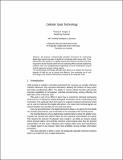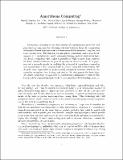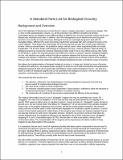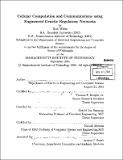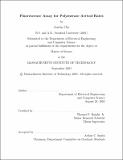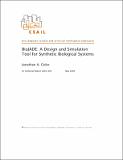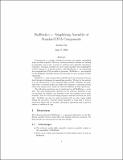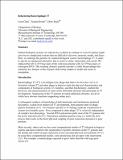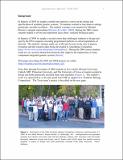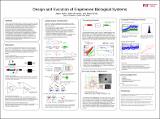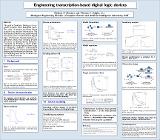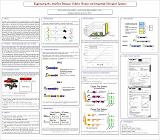Browsing Communications by Issue Date
Now showing items 1-20 of 55
-
Cellular Gate Technology
(First International Conference on UNCONVENTIONAL MODELS OF COMPUTATION, Auckland, New Zealand, 1998-01-05)We propose a biochemically plausible mechanism for constructing digital logic signals and gates of significant complexity within living cells. These mechanisms rely largely on co-opting existing biochemical machinery and ... -
Amorphous Computing
(1999-08-29)Amorphous computing is the development of organizational principles and programming languages for obtaining coherent behaviors from the cooperation of myriads of unreliable parts that are interconnected in unknown, ... -
A Standard Parts List for Biological Circuitry
(DARPA White Paper, 1999-10-07)One of the hallmarks of biochemical circuits found in nature is analog, asymmetric, asynchronous design. That is, there is little standardization of parts, e.g. all the promoters have different strengths and kinetics, ... -
Cellular computation and communications using engineered genetic regulatory networks
(Massachusetts Institute of Technology, 2001)In this thesis, I present an engineering discipline for obtaining complex, predictable, and reliable cell behaviors by embedding biochemical logic circuits and programmed intercellular communications into cells. To accomplish ... -
DARPA BioComp Plasmid Distribution 1.00 of Standard Biobrick Components
(MIT Artificial Intelligence Laboratory, 2002-05-22)This distribution consists of 300 ng aliquots of plasmid DNA for each of twelve components and compound constructs utilizing our idempotent assembly strategy. The dried DNA should be stable at room temperature for many ... -
Idempotent Vector Design for Standard Assembly of Biobricks
(MIT Artificial Intelligence Laboratory; MIT Synthetic Biology Working Group, 2003)The lack of standardization in assembly techniques for DNA sequences forces each DNA assembly reaction to be both an experimental tool for addressing the current research topic, and an experiment in and of itself. One ... -
Fluorescence Assay for Polymerase Arrival Rates
(2003-08-31)To engineer complex synthetic biological systems will require modular design, assembly, and characterization strategies. The RNA polymerase arrival rate (PAR) is defined to be the rate that RNA polymerases arrive at a ... -
Strategy for Biological Risk & Security
(2003-10)Why do biological risks exist? Can we develop and implement a strategy for thoughtfully approaching future biological risks? This short, working report provides an abstract introduction to the problem of biological risk ... -
Fluorescence assay for polymerase arrival rates
(Massachusetts Institute of Technology, 2004)To engineer complex synthetic biological systems will require modular design, assembly, and characterization strategies. The RNA polymerase arrival rate (PAR) is defined to be the rate that RNA polymerases arrive at a ... -
BioJADE: A Design and Simulation Tool for Synthetic Biological Systems
(2004-05-28)The next generations of both biological engineering and computer engineering demand that control be exerted at the molecular level. Creating, characterizing and controlling synthetic biological systems may provide us ... -
BioBricks++: Simplifying Assembly of Standard DNA Components
(2004-06-09)Construction of complex biological systems can require assembling many modules together. However, existing assembly schemes are lacking in generality, ease of use, or power to perform some desirable operations. Currently, ... -
Refactoring Bacteriophage T7 (2004 version)
(2004-10)Natural biological systems are selected by evolution to continue to exist. Evolution might give rise to complicated systems that are difficult to discover, measure, model, and direct. Here, we redesign the genome of a ... -
Engineering the Interface Between Cellular Chassis and Integrated Biological Systems
(2005-08-08)The engineering of biological systems with predictable behavior is a challenging problem. One reason for this difficulty is that engineered biological systems are embedded within complex and variable host cells. To help ... -
Design and Evolution of Engineered Biological Systems
(2005-08-11)To date, engineered biological systems have been constructed via a variety of ad hoc approaches. The resulting systems should be thought of as pieces of art. Here, I propose to explore how existing forward engineering ... -
iGEM 2005 Invitation Supplement
(2005-09-29)This document provides background material in support of the 2005 intercollegiate Genetically Engineered Machine Competition (aka iGEM). Herein, you can read quick summaries of earlier competitions and courses, obtain a ... -
Design and Evolution of Engineered Biological Systems
(Sixth International Conference on Systems Biology, 2005-10-20)To date, engineered biological systems have been constructed via a variety of ad hoc approaches. The resulting systems should be thought of as pieces of art. We are interested in exploring how existing forward ... -
Engineering transcription-based digital logic devices
(Sixth International Conference on Systems Biology, 2005-10-20)The goal of Synthetic Biology is to engineer systems from biological parts. One class of systems are those whose purpose is to process information. My work seeks to build transcription-based devices for use in combinational ... -
Engineering the Interface Between Cellular Chassis and Integrated Biological Systems
(2005-10-21)The engineering of biological systems with predictable behavior is a challenging problem. One reason for this difficulty is that engineered biological systems are embedded within complex and variable host cells. To help ... -
Rapid Characterization of Cellular Pathways Using Time-Varying Signals
(International Conference on Systems Biology, 2005-10-21)The use of traditional tools for the discovery and characterization of biological systems has resulted in a wealth of biological knowledge. Unfortunately, only a small portion of the biological world is well-understood ... -
Adventures in Synthetic Biology
(OpenWetWare & Nature Publishing Group, 2005-11-24)
